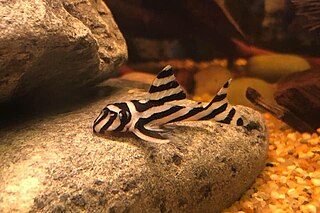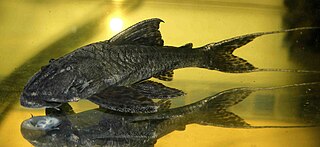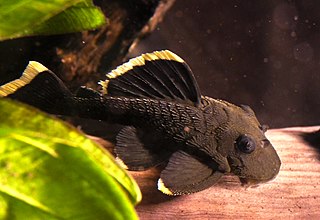
Hypostomus plecostomus, also known as the suckermouth catfish or the common pleco, is a tropical freshwater fish belonging to the armored catfish family (Loricariidae), named for the longitudinal rows of armor-like scutes that cover the upper parts of the head and body. Although the name Hypostomus plecostomus is often used to refer to common plecostomus sold in aquarium shops, most are actually members of other genera.

The zebra pleco is a species of catfish endemic to Brazil where it occurs in the Big Bend area of the Xingu River, a tributary of the Amazon River, and was first described in the early 1990s. It gets its name from its black and white stripes, resembling the colouration of a zebra. This species grows to a length of 6.4 centimetres (2.5 in) SL. This fish was exported from Brazil in great numbers for sale as aquarium fish. However, currently the Brazilian government bans the export of certain Hypancistrus, including H. zebra.

Baryancistrus is a genus of freshwater Loricariid catfish. They inhabit flowing sections of rivers, especially clearwater, in the basins of the Amazon and Orinoco in Brazil and Venezuela. The largest species reach up to 34 cm (13 in) in total length.
Hisonotus is a genus of armored catfishes native to South America. Species of Hisonotus and Curculionichthys are the only representatives of the subfamily Otothyrinae having serrae on the posterior edge of the pectoral fin spine. These species are small fishes, generally found in small fast flowing streams, where they grasp to the branches and leaves of aquatic or subaquatic plants. The species of this genus mostly occur in Atlantic coastal streams of southern Brazil and the Paraguay-Paraná system of southern South America. They are also distributed in the Río de La Plata basin and coastal rivers of southeastern Brazil.

The Hypostominae are a subfamily of catfishes of the family Loricariidae. Most members of the subfamily are restricted to tropical and subtropical South America, but there are also several species in southern Central America. Hypostomus plecostomus, which is popular in the aquarium trade, has been introduced to several regions far from its native range.

Ancistrini is a tribe of catfishes of the family Loricariidae. Most are restricted to tropical and subtropical South America, but there are also several genus in southern Central America.

Pseudacanthicus is a genus of medium to large-sized suckermouth armored catfishes native to South America, where found in the Amazon and Orinoco basins, as well as rivers of the Guianas. They are primarily found in fast-flowing waters, sometimes relatively deep. They are sometimes kept in aquariums.

Panaqolus is a genus of small catfish in the family Loricariidae native to rivers in tropical South America. Its members were formerly thought to belong to a clade of small-sized species in the genus Panaque, until this genus was separated from Panaque in 2001. At times it has been considered a subgenus of Panaque, and the validity of the genus has been disputed by various authors and sources. Pseudoqolus koko was formerly considered to be a member of this genus, although it was reclassified as a member of the currently monotypic genus Pseudoqolus by Nathan K. Lujan, Christian A. Cramer, Raphael Covain, Sonia Fisch-Muller, and Hernán López-Fernández following a 2017 molecular phylogenetic analysis.

Peckoltia vittata is a species of catfish belonging to the subfamily Hypostominae of the family Loricariidae.

Panaque armbrusteri is a species of fish in the South American armoured catfish family Loricariidae. This species is distributed throughout the Tapajós river, a large tributary of the Amazon River, with similar populations found in the Xingu, Araguaia, Tocantins and Aripuanã rivers, although it is uncertain whether these populations comprise the same or different species. P. armbrusteri is a large loricariid, reaching 43 cm in total length and reportedly weighing up to 1.3 kg.

Peckoltia pankimpuju is a species of armored catfish from the family Loricariidae, native to the Marañón River in the upper Amazon basin of Peru. It is commonly called the coal pleco, Peruvian lyre-tail, and L350 under the L-number code. It reaches up to about 40 cm (16 in) in length.
Ancistrus ranunculus is a species of catfish in the family Loricariidae. It is native to South America, where it occurs in the basins of the Xingu River and the Tocantins River in Brazil. It inhabits areas with clear water and without strong currents, and it is known to inhabit narrow cracks in submerged rocks, small passages, and spaces below flat rocks. The species is large for a member of Ancistrus, reaching 19.5 cm in total length. It sometimes appears in the aquarium trade, where it is one of several species known as a medusa pleco, although it may be referred to by its L-number, L034.

Baryancistrus chrysolomus is a species of catfish in the family Loricariidae. It is native to South America, where it occurs in the Xingu River basin in Brazil. Adults of the species are most frequently found under flat rocks on the river bottom in places with fine sediments, whereas juveniles are found under rocks in marginal areas near river banks. The species reaches 29.6 cm in total length and feeds on the diatoms and invertebrate larvae associated with fine sediments such as sand. It is present in the aquarium trade, where it is referred to as the mango pleco or by its L-number, L-047.

Panaqolus albivermis is a species of catfish in the family Loricariidae. It is native to South America, where it occurs in the San Alejandro River, which is a tributary of the Ucayali River in Peru. The species reaches 9.6 cm SL.
Panaqolus albomaculatus is a species of catfish in the family Loricariidae. It is native to South America, where it occurs in the headwaters of the Napo River, the Marañón River, and the Ucayali River. The species reaches 12.4 cm SL. It is sometimes seen in the aquarium trade, where it is typically referred to either as the mustard-spot pleco, the orange-spot pleco, or by its L-number, which is LDA-031.
Panaqolus changae is a species of catfish in the family Loricariidae. It is native to South America, where it occurs in the basins of the Itaya River and the Momón River in Peru. The species reaches 8.5 cm SL and its specific epithet honors Fonchii Chang, a Peruvian ichthyologist of the National University of San Marcos. It appears in the aquarium trade, where it is referred to either as the Iquitos tiger pleco, referencing the fact that the species is known to occur near the city of Iquitos, or by its L-number, which is L-226.
Panaqolus claustellifer is a species of catfish in the family Loricariidae. It is native to South America, where it occurs in the Takutu River and the Branco River in Brazil and Guyana. The species reaches 6.2 cm SL. While not described until 2016, it was known to aquarists before its formal description. In the aquarium trade, it is typically referred to either as the blood-red tiger pleco or by one of its two associated L-numbers, which are L-306 and LDA-064. Its specific epithet means "keyhole-bearing" in Latin, referring to the distinctive markings present on the species' snout.
Pseudoqolus koko is a species of catfish in the family Loricariidae and the only species in the genus Pseudoqolus. It is a freshwater fish native to South America, where it occurs in the Maroni basin. It is usually found on or near stony substrates in the main river channel at a depth of around 2 m. The species has been collected alongside multiple other loricariid species, including Hemiancistrus medians, Peckoltia otali, Pseudancistrus barbatus, Harttia guianensis, Loricaria cataphracta, and Rineloricaria stewarti. It is noted that the gut contents of one specimen of this species contained primarily spicules and sponge fragments, indicating that it may feed on freshwater sponges. The species reaches 9 cm SL.
Panaqolus nix is a species of catfish in the family Loricariidae. It is native to South America, where it occurs in the Madeira River and the Mamoré River in Brazil, as well as the Madre de Dios River drainage basin in Peru. It is reported to have been caught in cofferdams at hydroelectric power plant construction sites in the Madeira River, with most specimens being collected at depths of 3.1 to 11 m in environments with a strong current. The species reaches 11.2 cm SL and is known to be quite variable in color. Its specific epithet, nix, derives from the Latin word for "snow", referring both to the species' characteristic white spots that are said to resemble snowflakes and the tendency of some individuals to be entirely pale.
Panaqolus purusiensis is a species of catfish in the family Loricariidae. It is native to South America, where it occurs in the Macauã River basin in the Purus River drainage in Brazil for which it is named, although it has also been recorded from the Curanja River, which is also part of the Purus drainage in Peru. The species reaches 13 cm SL. It was redescribed in 2014 by Christian A. Cramer due to a lack of information on the species from the original description, which was based on a single specimen.










